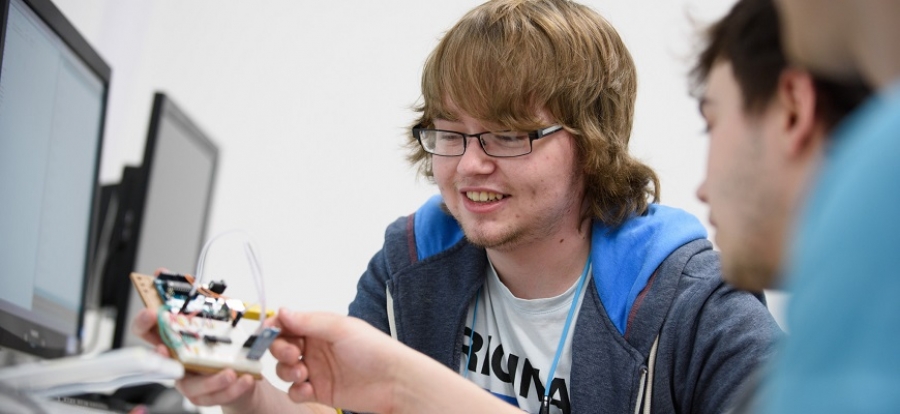Tim Head - Viking invasions
One of my favourite ways to use engage is through AR, using a nifty little app called Morfo. It allows you to create an animated face which you can make talk. However, Morfo’s party trick is it can also do this with any photo. You can take a photo of a child and turn them into a talking cartoon head. More powerfully, you can take a picture of a famous person and animate their face. I have done this with a viking warrior, Anne Frank and the leaders of World War 2 - it is incredible how engaging it can be when Anne reads an extract from her diary. Children can also add their own voices to characters, and therefore need to think carefully about what they are writing and the effect they wish to create. Children used the Morpho viking to record their own characters talking in the first person about their day as a viking settler. This made them really think about not only how they would speak, but how important accuracy was.
I really need to start using morfo again. pic.twitter.com/WxrukZdFwP
— Tim Head (@MrHeadComputing) August 7, 2016
Adam Chase - Disappear into a green screen!
Green screens - bright green, or sometimes blue, surfaces - are a fantastic edtech resource. It is the software, or in my case the app, that does the clever stuff. The green can be anything - green backing paper, a canvas, some paint or even the best one green screen money can buy. The two apps I rely on are Green Screen by Do Ink and Veescope. When I want a still background I tend to use Green Screen by Do Ink, but when I want something moving, I use Veescope. As a side note, you can get some brilliant effects by playing around with the colour wheel on both apps. On Green Screen by Do Ink, I have changed the colour selection to a beige/yellow and had children disappear in a Hollow Man-inspired horror film, which I then used for some exciting horror writing.
We’re having a magical day thinking about using green screen and animation ...#edtech #edtechchat @_geekyteacher pic.twitter.com/nBiSofigRw
— Teachers Vault (@teachersvaultuk) October 5, 2016
John Galloway - Handling SEN provision
Technology to support special educational needs and disabilities (SEND) can be very specialised. However, it is also widely available, if not necessarily known about. When it comes to determining provision, a lot of the time an assessment will be little more than a common-sense appraisal of what difficulties a learner is encountering, combined with an appreciation of the capabilities of the technology to hand. Sometimes, however, there is a need for specialist input. For instance, a child with cerebral palsy may need their equipment mounted in a particular way so that physical difficulties are not exacerbated when trying to use it. In such cases the input of an occupational therapist or physiotherapist will be helpful. Similarly, electronic devices that provide learners with a voice, need the support of a speech and language therapist in order that it fits with the learners level of language development.
Paul McGuire - Making a makerspace
There are countless resources out now on how to develop a makerspace, and great people on Twitter that you can follow. I also continue to collect blog posts and articles on makerspaces using LiveBinder - you can access all the articles here. I started out with Eric Sheninger’s post ‘Creating Our Own Unique Learning Environments #DigiLead’, but I don’t think there is any definitive article that sums up everything about maker culture. I may be biased, but I think one of the best guides on how to get started comes from my colleague Cathy Iverson, who wrote a series of guest posts on my blog. In April 2015, she wrote that a few simple things were important to consider when starting a makerspace:
- Research,
- Spend wisely,
- Ask for help,
- Connect activities to the curriculum (it’s not hard to do),
- Have fun.
Great Makerspace addition Squishy Kit's #FETC #ocsb #makerspaces pic.twitter.com/3qUf9ysyNj
— Paul McGuire (@mcguirp) January 12, 2016
Simon Davenport - Guerilla edtech
One edtech trend that’s growing is the use of technology to enhance creativity and imagination within schools, and enable learning to be truly placed in learners’ hands. While classrooms used to follow the ‘sage on stage’ set-up, it’s now about ‘bringing learning to life’ and giving pupils the opportunity to work and think autonomously, so that they can use their imagination to develop their own ideas and solutions to problems. Yes, they’re likely to stumble to begin, with as they’re not being given the answer on a plate, but often these situations provide students with some of the greatest learning opportunities. They must be resilient enough to try and try again, and use their problem-solving abilities and creativity to devise a successful solution or outcome. When learning is placed in pupils’ hands, it encourages them to become the resilient and adaptable thinkers needed for the future.
Have a read of the Innovate My School Guide 2017/18 at www.innovatemyschool.com/guides. Let us know what you think via [email protected].
Want to receive cutting-edge insights from leading educators each week? Sign up to our Community Update and be part of the action!


















